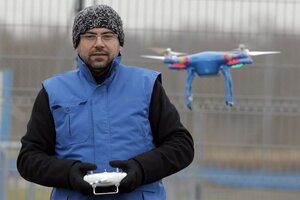Have flying drones hit their 'Macintosh moment'?
Will 3D Robotics and DJI turn this highflying hobby into mass market toys, or will drones remain a DIY affair?

French company Malou Tech CEO Philippe Dubus displays a drone DJI Phantom 2 during a demonstration flight in La Queue-en-Brie, east of Paris, France. For months, France has faced dozens of drone overflights over sensitive sites, mostly nuclear facilities, a worrisome development in a country that gets the highest percentage of its energy in the world from atomic power. France wants to monitor and detect intruding drones and their remote-control pilots; analyze and track their flight paths; and ultimately neutralize the drones,either temporarily or permanently, with the least collateral damage possible.
Francois Mori/AP
Not that long ago, drones were best left to the military. The idea of owning and flying your own seemed impossible. But a decade of technological advancements has made a successful consumer market for drones not only possible, but, for some, quite profitable.
For years now, these flying machines have been cobbled together in garages using low-priced sensors, accelerometers, gyroscopes, autopilot systems, processors, and cameras that can be combined to form a small aircraft.
But aside from hobbyists, do people want to build their own drones?
The first home computers in the 1970s were build-your-own kits. But Apple co-founder Steve Jobs realized that while people wanted computers, many didn’t want to build them themselves. Apple forged a path to the mass market, creating computers with no assembly required. This "Macintosh moment" changed the course of computing.
The same seems to be coming true for drones. Former Wired editor Chris Anderson is looking to capitalize on that. Like Mr. Jobs, Mr. Anderson started as a hobbyist. "This is a classic grassroots, bottom-up approach," Anderson told Gizmodo. "The pace of innovation on the grassroots is so much faster."
Anderson’s company, 3D Robotics, merges the DIY market with the consumer one in an attempt to turn drones into a multi-billion dollar industry.
3D Robotics sells two pre-assembled drones – the IRIS+ for $750 and the OX+ for $1,350 – as well as a variety of parts that can be added to either to customize the product. These additional controllers, GoPros, SD cards, radios, and aerial mapping equipment allow for the products to have a personal touch without the work of fully constructing it yourself.
DJI, one of the biggest names in drones right now, makes the $1,099 Phantom consumer drone that is ready to fly right out of the box.
While the future of drone regulations remains uncertain, at least for the time being, the possibilities for consumer drones are endless.

